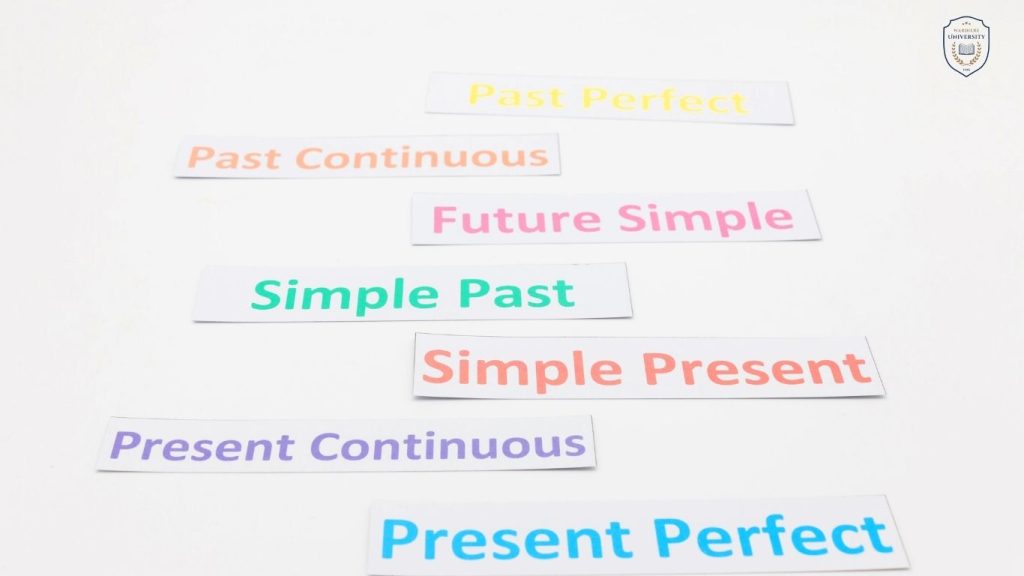The present continuous tense exists as a fundamental English grammar element which helps us describe ongoing activities that happen right now and in the immediate future. The present tense form of “to be” (am/is/are) combines with a present participle ending in -ing to create the structure which enables speakers to express real-time activities and temporary events and future plans. The present tense serves as a fundamental component of successful communication because it shows the active present time which people need for their spoken and written exchanges. The present continuous tense functions as a tool which helps people display their current activities during everyday chats and official document writing. Learning this tense allows students to speak correctly while developing their complete language abilities which makes it essential for English learners.
Formation of the Present Continuous Tense
English grammar depends on the present continuous tense to show actions which happen during speaking or ongoing activities. The present continuous tense requires the present tense of “to be” as its base which demands the auxiliary verbs “am” or “is” or “are” before the main verb that needs to have an -ing ending. The construction allows users to show ongoing activities in their descriptions.
1. Auxiliary Verb:The auxiliary verb “to be” changes its form based on the subject which appears in the sentence. This means:
– Use “am” with the first person singular (I).
– Use “is” with third person singular subjects (he, she, it).
– Use “are” with second person singular/plural and first/third person plural subjects (you, we, they).
2. Main Verb with -ing:The present continuous tense requires the main verb to receive an -ing ending. The verb changes into present participle form through this process which shows that the action happens right now.
– Example Sentences:
– “I am reading a fascinating book.”The auxiliary verb “am” functions as the main verb for “I” while “reading” operates as the main verb in its -ing form.
– “She is cooking dinner right now.”The subject “she” links to “is” in this sentence while “cooking” shows what she is doing.
– “They are playing soccer in the park.”The subject “they” links to “are” in this sentence while “playing” shows what they are doing.
The present continuous tense depends on this structure to function correctly because it helps people describe temporary actions and ongoing events and planned future activities in their everyday speech. The speakers need to learn this tense because it enables them to show actions that happen at the moment of speaking with clarity and effectiveness.
Usage of the Present Continuous Tense
English grammar depends on the present continuous tense because it enables speakers to describe present actions and short-term events and scheduled upcoming events. Learning how to apply this tense in different situations will improve your communication skills because it allows you to express ongoing activities with exactness and clarity. The present continuous tense functions best in these main situations.
1. Actions Happening Now: People use the present continuous tense to describe actions which take place at this exact second according to this fundamental rule. The speaker needs to show immediate actions so this application becomes essential.
– Example: “She is talking to her friend.” The sentence shows that someone is talking right now which proves the action occurs at the moment of speaking.
2. Temporary Situations: The present continuous tense functions as a tool to describe temporary situations which occur during a specific time period. The time frame shows that this condition or behavior exists only during a certain period.
– Example: “I am staying at my friend’s house this week.” The speaker shows that their current living situation is temporary because they indicate it differs from their permanent home.
3. Future Plans or Arrangements:The present continuous tense functions beyond its present meaning because it allows speakers to describe upcoming scheduled events. People use this expression in informal situations to talk about events which will definitely happen.
– Example: “We are meeting them at 6 PM.” The present continuous tense shows that the meeting has been scheduled and will occur at the specific time mentioned.
Everyday language becomes more expressive when people use the present continuous tense because it allows them to show ongoing activities and changing circumstances. The present continuous tense functions as a strong grammatical instrument which enables writers to express ongoing activities that happen right now or in the near future or temporary states. Learning this skill helps you produce grammatically correct writing which also allows you to create meaningful descriptive content.
Examples of this Tense
English grammar depends on the present continuous tense as a fundamental structure which allows speakers to describe different actions and ongoing situations. The real-world examples of this tense demonstrate how it functions in different situations. The present continuous tense functions to express present activities and short-term occurrences and scheduled events which we will examine through three basic examples.
1.The present continuous tense serves to express actions which happen during the exact moment when someone speaks. The method proves useful when users want to show that a particular task remains active at the moment.
– Example: “The baby is sleeping right now.” The speaker concentrates on the present moment of the baby’s sleep state during the time they speak. The snapshot reveals the current time period through a snapshot of present activities.
2.The tense functions to describe short-term events which happen only for a limited time according to its definition. The description shows ongoing activities which have defined time limits or specific end dates.
– Example: “They are working on a project this month.” The sentence shows that the person will work during the current month only. The person shows their temporary commitment to the project through this statement because they do not mention any ongoing or indefinite work.
3.The present continuous tense functions to describe future plans according to its standard usage. The method appears regularly in informal speech when people talk about their planned future activities.
– Example: “We are visiting the museum tomorrow.” The sentence shows that the speaker has arranged to go somewhere in the future. The present continuous tense shows that the speaker has planned the visit and expects it to happen according to the arranged schedule.
This tense shows its various uses through these examples. The tense enables speakers to describe present actions and short-term events and upcoming planned activities which results in well-structured ongoing activity stories. The tense functions as a vital tool for people to enhance their communication abilities because it helps them create vivid descriptions and accurate representations of present and upcoming tasks.
The English language depends on the present continuous tense to show active events and short-term conditions properly. The system supports both present action descriptions and future appointment scheduling which makes it valuable for different operational environments. Learning proper present continuous tense usage in English enables people to develop better language skills which results in more interesting conversations. The present tense allows speakers to tell stories and describe their current work and future plans because it offers both the flexibility and precision needed for clear communication. Students who study English will develop better language skills by learning the present continuous tense because it helps them speak fluently in work and social settings. People learn to use this tense correctly through practice which leads to better communication skills in their spoken and written language.
Keywords:
- present continuous tense
- present continuous wordwall
- present simple
- present perfect
- present continuous exercises
- McHardy, V. (n.d.). Present continuous tense. Ecampus Ontario. Retrieved from https://ecampusontario.pressbooks.pub/verbtenses/chapter/present-continuous/
- British Council. (n.d.). Present continuous. LearnEnglish. Retrieved from https://learnenglish.britishcouncil.org/grammar/english-grammar-reference/present-continuous
- Scribbr. (2023). Present continuous tense: Examples & exercises. Scribbr. Retrieved from https://www.scribbr.com/verbs/present-continuous/


 Tiếng Việt
Tiếng Việt